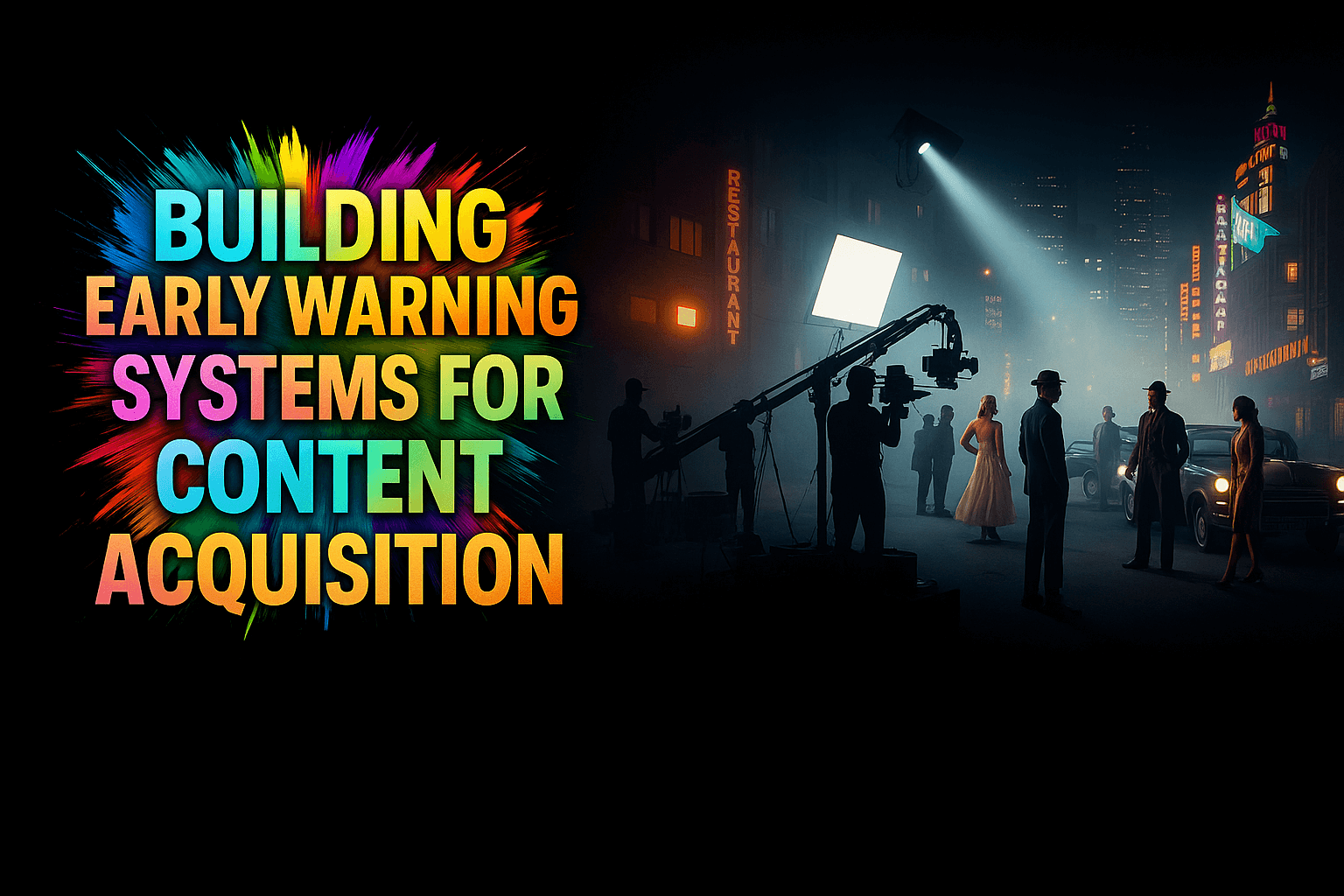Building Early Warning Systems for Content Acquisition: A Strategic Guide for Executives

Introduction
In the high-stakes, hyper-competitive world of media and entertainment, securing the right content is the ultimate challenge. The traditional model of content acquisition—a reactive scramble for completed films at festivals or a bidding war for a high-profile series—is a path to diminishing returns.
By the time a project is widely available, its value has often been commoditized. For senior content acquisition executives, the new strategic imperative is a shift from a reactive to a proactive model.
This requires building early warning systems for content acquisition, which enables you to identify and engage with a project at its earliest, most valuable stages.
This guide will provide a strategic blueprint for this new approach, detailing its core components and demonstrating how a data-first platform can transform your competitive intelligence. I will break down the key challenges and present a new operational model.
Key Takeaways
| Core Challenge | Fragmented data and a reactive approach lead to missed opportunities and inefficient bidding wars for high-value content. |
| Strategic Solution | Implement an early warning system that uses real-time, verified data to provide early visibility into the global project pipeline. |
| Vitrina’s Role | Vitrina serves as the foundation of your early warning system, providing a continuously updated projects tracker that links projects to key decision-makers and companies. |
The Strategic Imperative: The Shift from Reactive to Proactive
The entertainment industry’s content pipeline is a torrent of information. Thousands of projects are in development at any given time, but only a fraction will ever reach a screen.
For content acquisition professionals, the challenge is separating the signal from the noise and gaining a forward-looking view of the industry. Traditional methods, which often involve relying on trade publications and personal networks, are no longer sufficient.
By the time a project appears in a trade magazine, it has likely already been in development for months, and key decisions have been made. To truly compete in a global market, an executive must have early visibility into a project’s lifecycle—from the moment a script is optioned to when a production team is attached.
This kind of early insight is the essence of an effective content acquisition strategy and is the reason for building early warning systems for content acquisition.
The Core Challenge: The High Cost of Outdated Information
The biggest obstacle to a proactive acquisition strategy is information fragmentation. Data about a single project—its status, key personnel, financiers, and distribution partners—is scattered across dozens of different sources, from industry databases and news sites to festival catalogs and social media.
The time and resources spent on this kind of manual research represent a significant, hidden cost to your business. This is a fundamental pain point in the entertainment supply chain that leads to a series of high-level risks and inefficiencies.
Without a centralized early warning system, executives face several critical issues. You risk misallocating capital by entering bidding wars for projects you could have secured at an earlier, lower-cost stage.
You could miss a hit project entirely because you were unaware of its early-stage development. You also lack a holistic view of a competitor’s slate, making it difficult to understand their strategic direction.
Ultimately, the reliance on outdated information leads to missed opportunities, poor investment decisions, and a slow, inefficient workflow.
Building a Modern Framework for Content Acquisition
An early warning system is not a single piece of software but a strategic framework built on three core pillars:
- Risk Knowledge: The foundation is a comprehensive understanding of the market. This includes not just the data on what projects are in development but also an understanding of the companies and people involved. As a model from the MDPI Journal of Applied Sciences notes, risk knowledge is key to effective early warning systems.
- Continuous Monitoring: The system must provide a continuous feed of data on new and developing projects. This requires moving beyond static databases and into a model of real-time tracking, allowing you to monitor project status as it moves from development to production.
- Actionable Insights: Raw data is not enough. The system must transform data into intelligence by showing the relationships between a project, its producers, financiers, and distribution partners. This is how you move from simple tracking to actionable intelligence.
Vitrina: The Single Source of Truth for Your Early Warning System
The strategic framework outlined above is only possible with a platform that can provide the necessary data. This is where Vitrina comes in. Vitrina is a global platform that tracks the entire entertainment supply chain—film and TV content, companies, collaborations, and decision-makers.
It is designed to be the single source of truth for M&E professionals, allowing you to build a true early warning system.
Vitrina’s core capabilities are a direct answer to the challenges of manual research. Our Film & TV Projects Tracker provides granular visibility into thousands of projects globally, from their inception to their release.
The platform’s ability to cross-reference this project data with its extensive profiles of over 3 million executives and companies allows you to go beyond simply tracking a project.
You can see who is involved, their past deal track record, and the strategic relationships between partners. This level of detail is simply unattainable through traditional, fragmented research methods and gives you a powerful competitive advantage.
How Vitrina Enables Smarter Decisions
Using a platform like Vitrina is about more than just data; it’s about enabling a fundamentally more efficient and strategic workflow. Here are some specific use cases for how Vitrina helps you make smarter, more confident decisions:
- Informed Content Acquisition: Instead of waiting for a completed film to be shopped at a festival, you can use Vitrina to identify projects that are just entering pre-production. This early visibility allows you to engage in a pre-buy negotiation before a bidding war begins. The platform provides a clear, data-backed view of a project’s potential.
- Proactive Vetting: When a potential partner pitches a project, you can use Vitrina to quickly vet their reputation and credentials. You can see their full deal track record, their previous collaborators, and the type of content they have successfully produced. This helps you de-risk content financing by ensuring you are partnering with credible entities.
- Competitor Intelligence: A real-time system allows you to monitor a competitor’s strategic movements. You can see if a rival streamer is moving heavily into a specific genre or a regional market, allowing you to calibrate your own investment strategy in response.
Conclusion
The future of content acquisition belongs to those who can master the flow of information. The era of manual, fragmented research is over, replaced by the strategic necessity of building early warning systems for content acquisition.
By implementing a modern framework and leveraging a single source of truth like Vitrina, executives can transform their approach to content acquisition and financing.
The ability to track a project from its nascent stage to its final release, to understand the web of relationships between companies and individuals, and to identify new opportunities before they hit the open market is the key to securing a strategic advantage in a fast-paced global market.
Frequently Asked Questions
An early warning system is a strategic framework that uses real-time, verified data to provide content acquisition professionals with early visibility into film and television projects, enabling them to identify and engage with content before it is widely available.
The key benefits include gaining a competitive advantage by identifying opportunities at their earliest, most valuable stage, avoiding costly bidding wars, and de-risking content financing by proactively vetting potential partners.
Traditional methods rely on fragmented, often outdated sources like trade publications and personal networks. An early warning system centralizes verified data, providing continuous, proactive intelligence on projects and industry trends.
These systems are used by a wide range of M&E professionals, including executives in content acquisition, film and television financing, co-production, and business development for production and post-production service vendors.

























